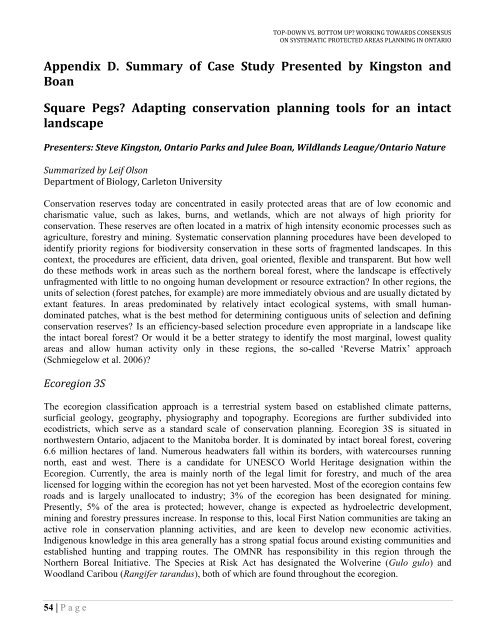Top-Down vs. Bottom Up: Working Towards Consensus ... - CASIOPA
Top-Down vs. Bottom Up: Working Towards Consensus ... - CASIOPA
Top-Down vs. Bottom Up: Working Towards Consensus ... - CASIOPA
- No tags were found...
You also want an ePaper? Increase the reach of your titles
YUMPU automatically turns print PDFs into web optimized ePapers that Google loves.
TOP-DOWN VS. BOTTOM UP? WORKING TOWARDS CONSENSUSON SYSTEMATIC PROTECTED AREAS PLANNING IN ONTARIOAppendix D. Summary of Case Study Presented by Kingston andBoanSquare Pegs? Adapting conservation planning tools for an intactlandscapePresenters: Steve Kingston, Ontario Parks and Julee Boan, Wildlands League/Ontario NatureSummarized by Leif OlsonDepartment of Biology, Carleton UniversityConservation reserves today are concentrated in easily protected areas that are of low economic andcharismatic value, such as lakes, burns, and wetlands, which are not always of high priority forconservation. These reserves are often located in a matrix of high intensity economic processes such asagriculture, forestry and mining. Systematic conservation planning procedures have been developed toidentify priority regions for biodiversity conservation in these sorts of fragmented landscapes. In thiscontext, the procedures are efficient, data driven, goal oriented, flexible and transparent. But how welldo these methods work in areas such as the northern boreal forest, where the landscape is effectivelyunfragmented with little to no ongoing human development or resource extraction? In other regions, theunits of selection (forest patches, for example) are more immediately obvious and are usually dictated byextant features. In areas predominated by relatively intact ecological systems, with small humandominatedpatches, what is the best method for determining contiguous units of selection and definingconservation reserves? Is an efficiency-based selection procedure even appropriate in a landscape likethe intact boreal forest? Or would it be a better strategy to identify the most marginal, lowest qualityareas and allow human activity only in these regions, the so-called „Reverse Matrix‟ approach(Schmiegelow et al. 2006)?Ecoregion 3SThe ecoregion classification approach is a terrestrial system based on established climate patterns,surficial geology, geography, physiography and topography. Ecoregions are further subdivided intoecodistricts, which serve as a standard scale of conservation planning. Ecoregion 3S is situated innorthwestern Ontario, adjacent to the Manitoba border. It is dominated by intact boreal forest, covering6.6 million hectares of land. Numerous headwaters fall within its borders, with watercourses runningnorth, east and west. There is a candidate for UNESCO World Heritage designation within theEcoregion. Currently, the area is mainly north of the legal limit for forestry, and much of the arealicensed for logging within the ecoregion has not yet been harvested. Most of the ecoregion contains fewroads and is largely unallocated to industry; 3% of the ecoregion has been designated for mining.Presently, 5% of the area is protected; however, change is expected as hydroelectric development,mining and forestry pressures increase. In response to this, local First Nation communities are taking anactive role in conservation planning activities, and are keen to develop new economic activities.Indigenous knowledge in this area generally has a strong spatial focus around existing communities andestablished hunting and trapping routes. The OMNR has responsibility in this region through theNorthern Boreal Initiative. The Species at Risk Act has designated the Wolverine (Gulo gulo) andWoodland Caribou (Rangifer tarandus), both of which are found throughout the ecoregion.54 | P a g e


